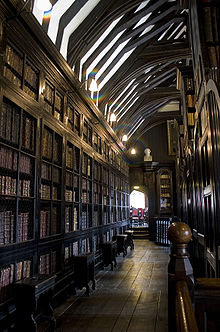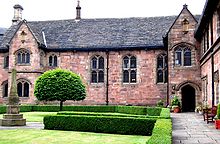- Chetham's Library
-
Chetham's Library in Manchester, England is the oldest free public reference library in the United Kingdom.[1] Chetham's Hospital, which contains both the library and Chetham's School of Music, was established in 1653 under the will of Humphrey Chetham (1580–1653), for the education of "the sons of honest, industrious and painful parents",[1] and a library for the use of scholars. The library has been in continuous use since 1653. It operates as an independent charity, open to readers and visitors free of charge.
The library holds more than 100,000 volumes of printed books, of which 60,000 were published before 1851. They include collections of 16th- and 17th-century printed works, periodicals and journals, local history sources, broadsides and ephemera.
Chetham's was the meeting place of Karl Marx and Friedrich Engels when Marx visited Manchester. The economics books Marx was reading at the time can be seen on a shelf in the library, as can the window seat where Marx and Engels would meet.
Contents
History
The manor house of the Lord of the Manor, in the centre of the medieval town of Manchester, stood on a sandstone bluff, at the confluence of the River Irwell and the River Irk. In 1421 the rector of the parish church, Thomas de la Warre (Lord of the manor of Manchester), obtained a licence from Henry V to refound the church as a collegiate foundation. He donated his manor house for use as the college of priests' buildings for the collegiate church (later to be the cathedral). There was accommodation for the warden, eight fellows, four clerks, and six choristers.
The Manchester Free Grammar School for Lancashire Boys was built between the church and the college buildings between 1515 and 1518. The college was dissolved in 1547 by the Chantries Act and sold to the Earl of Derby. It was re-founded as a catholic foundation by Queen Mary and again disbanded by Protestant Queen Elizabeth I. In 1578 it was re-founded by charter as Christ's College and re-occupied by the warden and fellows. In the Civil War it was used as a prison and arsenal. In 1653 the college buildings were bought with the bequest of Humphrey Chetham, for use as a free library and blue coat charity school. At that time there was no facility for independent study in the north of England and Chetham's will of 1651 had stipulated that the Library should be 'for the use of schollars and others well affected', and instructed the librarian 'to require nothing of any man that cometh into the library'.[2] The twenty four feoffees, or governors, appointed by Humphrey Chetham, set out to acquire a major collection of books and manuscripts that would cover the whole range of available knowledge and would rival the college libraries of Oxford and Cambridge.[2] In order to protect the newly acquired books from rising damp the Library was housed on the first floor and, in accordance with the provisions of Chetham's will, the books were chained to the presses (bookcases).[2] Twenty-four carved oak stools with 'S'-shaped hand-holds (which are still in use) were provided as seats for readers.[2]
In 1718 the feoffees offered the Manchester poet and inventor of a system of shorthand, John Byrom, the post of Library Keeper. Byrom, who was an avid collector of books, declined the offer but after his good friend, Robert Thyer, became Librarian in 1732, frequently acted as an agent for the library, purchasing books at London auctions.[3] Byrom's library, which included the manuscript of his poem "Christmas Day" (which became the Christmas carol, "Christians Awake") and some 2,800 printed books, was presented to the library by his descendant, Eleanora Atherton, in 1870.[3]
The books were originally uncatalogued and placed in the presses in size order. The first catalogue wasn't produced until 1791, and then was written in Latin and only listed the size and subject of each book.[2] The practice of chaining the books was abandoned in the mid eighteenth century when gates were erected to prevent theft.[2]
Additions were made to the buildings by J. E. Gregan (1850s), Alfred Waterhouse (1878) (grade II listed), and J. Medland Taylor (1883–95). Manchester Grammar School was extended along Long Millgate in 1870. Manchester Grammar School moved to Fallowfield in the 1930s, and after standing empty for many years the original building was destroyed during the Second World War, leaving only its new block. This became part of Chetham's School of Music in 1978. The old college building, which became the music school in 1969, still incorporates Chetham's Library and is Grade I listed.
Librarians
Past librarians include Robert Thyer (1709–1781), who became Librarian in 1732.[3][4] Peter Hordern (died 1836) was librarian and also the minister of St Clement's Chapel, Chorlton-cum-Hardy. Thomas Jones held the position from 1845 to 1875; during his time, the size of the library more than doubled (from 19,000 volumes to 40,000 volumes). He also produced a two-volume catalogue of the library's collection in 1862 and 1863.[5]
See also
References
Notes
- ^ a b Nicholls (2004), p. 20.
- ^ a b c d e f Anon. "A Brief History of Chetham's". Chetham's library official website. http://www.chethams.org.uk/history.html. Retrieved 1 June 2010.
- ^ a b c Anon. "Byrom Collection". Printed books and ephemera. Chetham's Library. http://www.chethams.org.uk/collections_byrom.html. Retrieved 1 June 2010.
- ^ Among his works was The Genuine Remains in Verse and Prose of Mr. Samuel Butler, author of Hudibras; Published from the original manuscripts, formerly in the possession of W. Longueville, Esq.; with notes by R. Thyer, Keeper of the Public Library at Manchester. 2 vols. London: J and R. Tonson, 1759
- ^ Sutton, C. W.; Crosby, Alan G. (2004). "Jones, Thomas (1810–1875)". Oxford Dictionary of National Biography. Oxford University Press. http://www.oxforddnb.com/view/article/15097. Retrieved 2009-01-27.
Bibliography
External links
- Details from listed building database (388291) Chethams Hospital and Attached wall - Grade I. Images of England. English Heritage.
- Details from listed building database (388292) Detached block, Alfred Waterhouse - Grade II. Images of England. English Heritage.
- Details from listed building database (388293) Hyde's Cross - Grade II. Images of England. English Heritage.
- Details from listed building database (388294) South east wing, formerly Manchester Grammar School - Grade II. Images of England. English Heritage.
- Chetham's Library website
Categories:- Public libraries in Greater Manchester
- Libraries in Manchester
- 1653 establishments in England
- Grade I listed buildings in Manchester
- Grade II listed buildings in Manchester
- Grade I listed library buildings
- Alfred Waterhouse buildings
Wikimedia Foundation. 2010.


